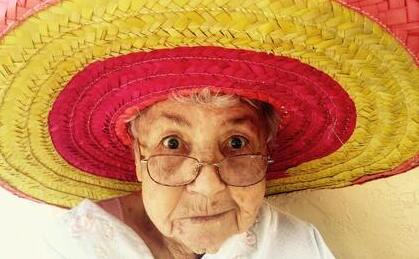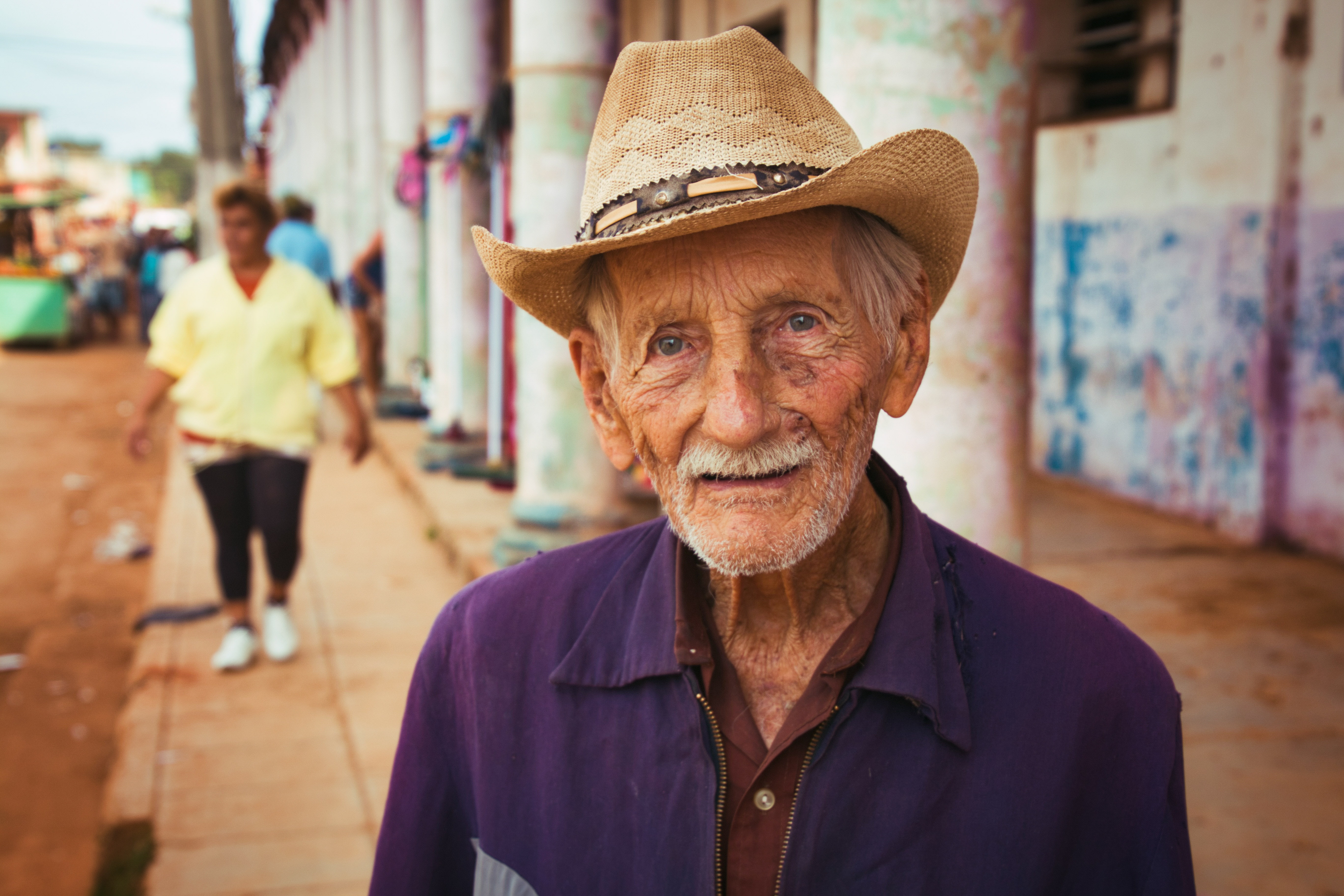10.6: Personality and Emotional Well-Being in Late Adulthood
- Last updated
- Save as PDF
- Page ID
- 71029
Personality and Self-Related Processes
Have you ever heard anyone say something like, "Old people are all alike. They all eat the same kind of food, wear the same kind of clothes and have the same kind of haircuts"? It isn't because they age that you may find such similarities. It is because they belong to a cohort that experienced the same historical events and environmental conditions, just as you did (and are doing).

Figure 10.6.1: All elderly are not alike. (Unsplash license; Alex Harvey via Unsplash)
Cohort Effects
A cohort is a group of people typically born around the same time or historical period, who share common experiences over time; sometimes called a generation (e.g., Baby Boom Generation or Millennial Generation).Your own age cohort has similarities as a result of the events of your times. Someday, people who are much younger than you will say things like, "All those Millennial old people are alike! They just want to carry their HUGE old iphones around while taking old school selfies and looking at cat videos while telling us how 'sick' that new GIF was!" See what I mean here? There will be things from your cohort that generations not yet born will identify you with. But...while there certainly are generational similarities for people due to being part of a cohort, there are also differences because people are individuals. Individual differences are just as pronounced among older people as among younger ones. You are you and unique in that. But, you are also part of a historical cohort which plays a role in your development as you age as well.
Self-Perceptions
One aspect of the self that particularly interests life span and life course psychologists is the individual’s perception and evaluation of their own aging and identification with an age group. Subjective age is a multidimensional construct that indicates how old (or young) a person feels and into which age group a person categorizes themselves. After early adulthood, most people say that they feel younger than their chronological age and the gap between subjective age and actual age generally increases. On average, after age 40 people report feeling 20% younger than their actual age (e.g., Rubin & Berntsen, 2006). Asking people how satisfied they are with their own aging assesses an evaluative component of age identity. Whereas some aspects of age identity are positively valued (e.g., acquiring seniority in a profession or becoming a grandparent), others may be less valued, depending on societal context. Perceived physical age (i.e., the age one looks in a mirror) is one aspect that requires considerable self-related adaptation in social and cultural contexts that value young bodies. Feeling younger and being satisfied with one’s own aging are expressions of positive self-perceptions of aging. They reflect the operation of self-related processes that enhance well-being. Levy (2009) found that older individuals who are able to adapt to and accept changes in their appearance and physical capacity in a positive way report higher well-being, have better health, and live longer.
Social Relationships
Much research focuses on the associations between specific effects of long-term social relationships and health in later life. Having friends is an especially strong predictor of mental health among older adults. Regarding marriage, older married individuals who receive positive social and emotional support from their partner generally report better health than their unmarried peers (Antonucci, 2001; Umberson, Williams, Powers, Liu, & Needham, 2006; Waite & Gallagher, 2000). Despite the overall positive health effects of being married in old age (compared with being widowed, divorced, or single), living as a couple can have a "dark side" if the relationship is strained or if one partner is the primary caregiver. The consequences of positive and negative aspects of relationships are complex (Birditt & Antonucci, 2008; Rook, 1998; Uchino, 2009). For example, in some circumstances, criticism from a partner may be perceived as valid and useful feedback whereas in others it is considered unwarranted and hurtful. In long-term relationships, habitual negative exchanges might have diminished effects. This is another reason having friends at this stage is important. Parent-child and sibling relationships are often the most long-term and emotion-laden social ties. Across the life span, the parent-child tie, for example, is characterized by a paradox of solidarity, conflict, and ambivalence (Fingerman, Chen, Hay, Cichy, & Lefkowitz, 2006).

Figure 10.6.2 (Unsplash license; Mary Blackwey via Unsplash)
Emotion and Well-being
As we get older, the likelihood of losing loved ones or experiencing declines in health increases. Does the experience of such losses result in decreases in well-being in older adulthood? Researchers have found that well-being differs across the life span and that the patterns of these differences depend on how well-being is measured.
Measures of global subjective well-being assess individuals’ overall perceptions of their lives. This can include questions about life satisfaction or judgments of whether individuals are currently living the best life possible. What factors may contribute to how people respond to these questions? Age, health, personality, social support, and life experiences have been shown to influence judgments of global well-being. It is important to note that predictors of well-being may change as we age. What is important to life satisfaction in young adulthood can be different in later adulthood. Early research on well-being argued that life events such as marriage or divorce can temporarily influence well-being, but people quickly adapt and return to their average baseline (called the hedonic treadmill; Diener, Lucas, & Scollon, 2006). The hedonic treadmill theory proposes that people eventually return to their own base range of happiness (higher or lower as the case may be for each person), regardless of what happens to them. More recent research suggests otherwise. Using longitudinal data, researchers have examined well-being prior to, during, and after major life events such as widowhood, marriage, and unemployment (Lucas, 2007). Different life events influence well-being in different ways, and individuals do not often adapt back to baseline levels of well-being. The influence of events, such as unemployment, may have a lasting negative influence on well-being as people age. Research suggests that self-reported well-being is actually highest in early adulthood and late adulthood and lowest in middle adulthood when there is a temporary U-shaped dip (which does not necessarily equate with the myth of the midlife crisis as you may recall). Other research finds that older adults report more positive and less negative affect than middle age and younger adults (Magai, 2008; Mroczek, 2001). It should be noted that both self-reported well-being and positive affect tend to taper off during late older adulthood and these declines may be accounted for by increases in health-related losses during these years (Charles & Carstensen, 2010).
The Six-factor Model of Psychological Well-being
Psychological well-being aims to evaluate the positive aspects of psychosocial development, as opposed to factors of ill-being, such as depression or anxiety. The Six-factor Model of Psychological Well-being is a theory developed by Carol Ryff, which determines six factors that contribute to an individual's psychological well-being, contentment, and happiness. Ryff’s Model proposes the following six core dimensions of positive well-being:
- Self-acceptance
- Personal growth
- Purpose in life
- Environmental mastery
- Autonomy
- Positive relations with others
Ryff’s model differs from other models in that it recognizes that well-being, like people, is multidimensional, and not merely about happiness, or "positive" emotions. A life well-lived is thought to be balanced, engaging each of the different aspects of well-being, instead of being too narrowly focused. Ryff roots her model from Aristotle’s Nichomachean Ethics, where the goal of life isn’t "feeling good" necessarily, but is, instead, about living optimally.
Research on this model has shown that older adults report higher levels of environmental mastery (feelings of competence and control in managing everyday life) and autonomy (independence), lower personal growth and purpose in life, and similar levels of positive relations with others as younger individuals. Links between health and interpersonal flourishing, or having high-quality connections with others, may be more important than previously thought in understanding how to optimize quality of life in old age.
The Impact of Ageism
Studying bias against old people is a relatively new phenomenon, partly because old people are a relatively new phenomenon. For hundreds of millennia, the average human lifespan rarely reached 40. There have always been some people who lived well beyond that age. Socrates, born in 470 B.C., died at 70 (of execution by poisoning, not age). Harriet Tubman, born in 1822, died at 91. But 20th century health care advancements and other factors caused life expectancy to skyrocket. An American born in 1900 lived, on average, just over 47 years. By 1960, that number had jumped to almost 70. Today, we can expect to live to about 80 (but we could like much longer).
Meanwhile, old people have become more segregated. Throughout most of human history, different generations usually lived together or nearby. But the Industrial Revolution lured younger people into cities for jobs, and urban living quarters couldn’t accommodate extended families, said psychologist Todd D. Nelson, of California State University Nelson, Stanislaus. Grandparents and great-grandparents were transformed from familiar household members into relatives who lived separately and often distantly. Nelson mentioned an even less obvious reason for the changing status of old people: the invention of the printing press. Before then, old people were respected sources of valuable knowledge handed down from earlier generations and accumulated through their years of experience. Books made knowledge readily obtainable from strangers.
This transition 500 years ago seems echoed in today’s supposed gap between “digital native” millennials and older people who, according to conventional wisdom, are technologically inept. Still another theory holds that ageism reflects our deep fears about dying. Death, once a normal household event, now usually occurs in nursing homes and hospitals — unfamiliar and unsettling places.
“Reminders of our mortality make us very anxious,” Nelson said. Casual ageism, on the other hand, isn’t even especially frowned upon. It’s so common it may seem routine, trivial, well-intentioned. But it’s not necessarily harmless. Researchers have found numerous links between cultural ageism and health problems — physical, cognitive and emotional — among older people.
Challenging ageism means getting people to pay closer attention to messages they’ve been hearing all their lives. These messages are found in jokes and insults and compliments and offhand remarks. They’re in the TV programs and commercials we watch (one study found that people who watched more TV held more anti-age biases). They’re posted on Facebook, which officially bans hate speech based on categories including race, nationality, religion and gender — but not age. They’re in the advertising claims that have built a $200 billion “anti-aging” industry of skin creams, Botox injections, hair coloring, hair restoration and cosmetic surgery.
From childhood on, Americans receive messages that old age means “you’re unhealthy, your mind is shot, you’re boring, you’re depressed and sad and lonely,” said Sally Brown of St. Paul, who teaches a course called “Aging With Gusto” through the St. Paul-based Vital Aging Network.
Negative Images
True, some older people are unhealthy or lonely — as are some young people. But similar characteristics are interpreted differently by age. A physically fit young person is healthy; a fit old person seems “younger.” A teenager losing the car keys is momentarily careless, an older person is developing dementia. Statements that denigrate older people’s functioning, thinking and appearance, advocates say, can lead to old people being stigmatized, isolated, ignored, politically disadvantaged and treated as “others.” Yet despite — or because of — the ubiquity of these messages, people rarely consider that they might be damaging. Compared with other common prejudices, ageism is rarely discussed.
“Ageism is a thing, just like racism and sexism, and it’s been under the radar for, well, forever,” said Todd D. Nelson, a psychologist at California State University, Stanislaus. While researching the psychology of prejudice in general, Nelson noticed the scarcity of information about ageism. So he published a book, Ageism: Stereo-typing and Prejudice Against Older Persons. “In my writing, I ask the very simple question: Why are we hiding that we’re getting older?” Nelson said. “It implies we’re ashamed of getting older, that it’s bad to get older. It’s so deeply embedded in our culture.”
Biases take different forms with different targets, so comparisons aren’t always valid, but sometimes swapping groups in a statement can highlight offensiveness. A birthday card that says “‘Ha ha ha, too bad you’re [insert ethnicity, religion, etc.],’” Nelson said, “wouldn’t go over so well.”
‘Everyone Is Ageist’
Ageism is a weird prejudice in several respects. For one, it has an ironic aspect: It’s a bias held by younger people against a group to which they will eventually belong — if they’re lucky. Nelson has called it “prejudice against our feared future selves.”
“Everyone is ageist because we are all biased,” said Ashton Applewhite, author of This Chair Rocks: A Manifesto Against Ageism and a blog of the same name. Everyday ageism is so widespread that people tend to use “young” and “old” as almost synonymous with positive versus negative traits. “Someone will say, ‘My mom is 94 but she’s not old,’” Applewhite said. Wrong. “She may be peppy, she maybe having wild sex every night, she may be a lingerie model, she may be a marathon runner. But she is old.”

Figure 10.6.3 (Unsplash license; Mehmet Turgut Kirkgoz via Unsplash)
A Self-Fulfilling Prophecy
People who accept negative age stereotypes are likelier to suffer cardiovascular problems and symptoms of Alzheimer’s, according to extensive research by Becca Levy, a professor of public health and psychology at Yale University. Meanwhile, Levy found that people with more positive images of aging had better psychiatric healthand physical functioning. Her subjects were studied over periods of years, minimizing the possibility that worsening health conditions shaped their outlook rather than the other way around. In one study, people over 60 with negative images of aging were more than 30 percent more likely to show memory decline. In another, people with positive images of aging lived longer by an average of 7.5 years.
Levy theorizes that young people are especially likely to absorb ageist stereotypes because they don’t identify with older people and feel no need to defend against the insults. Later, when they become old, they turn those attitudes back on themselves, experiencing health problems they’ve grown up expecting old people to experience.
Even health-care professionals may treat older patients differently than they do younger ones.
We’re All OK
Fighting ageism might begin with examining one’s own preconceptions and looking for ways to substitute upbeat thoughts for downers. Start thinking of old age as “a time of growth, learning, exploration, adventure,” Nelson suggested. Sally Brown agrees that people must change their mind-sets. “Embrace age as a natural process that begins at birth and continues throughout life,” she said. Remember that everybody gets older every day, and those who get to be old are the lucky ones.
Consider your own responses to ageist language or behavior — do you laugh politely at an ageist joke or point out that it’s problematic? Brown endorses challenging ageism when you encounter it. At the very least, don’t be complicit — don’t repeat the joke!
Even beauty magazines, traditionally purveyors of ageist attitudes, may be gaining awareness. Allure magazine announced on its September cover, with Helen Mirren, that it would stop using the term “anti-aging” and called on the industry to follow suit. “Growing older is a wonderful thing because it means that we get a chance, every day, to live a full, happy life,” the inside article said.
But lifelong lessons can be hard to escape. Even Brown admits she struggles not to feel flattered if someone tells her she looks younger than she is. “It’s really not a compliment,” she said. “It’s saying that who I really am is not OK. To make me be OK you have to tell me I’m younger than I am. Actually, people of every age are OK."
References and Attributions
This work is licensed under a Creative Commons Attribution 4.0
Lumen and Noba International License and remixed by Heather Valle
Lifespan Development, A Psychological Perspective Open Education Resource (OER) textbook funded by a grant from the College of Lake County Foundation and supported by the Business and Social Sciences Division.http://creativecommons.org/licenses/by-nc-sa/3.0/ by Martha Lally and Suzanne Valentine-French remixed by Heather Valle

